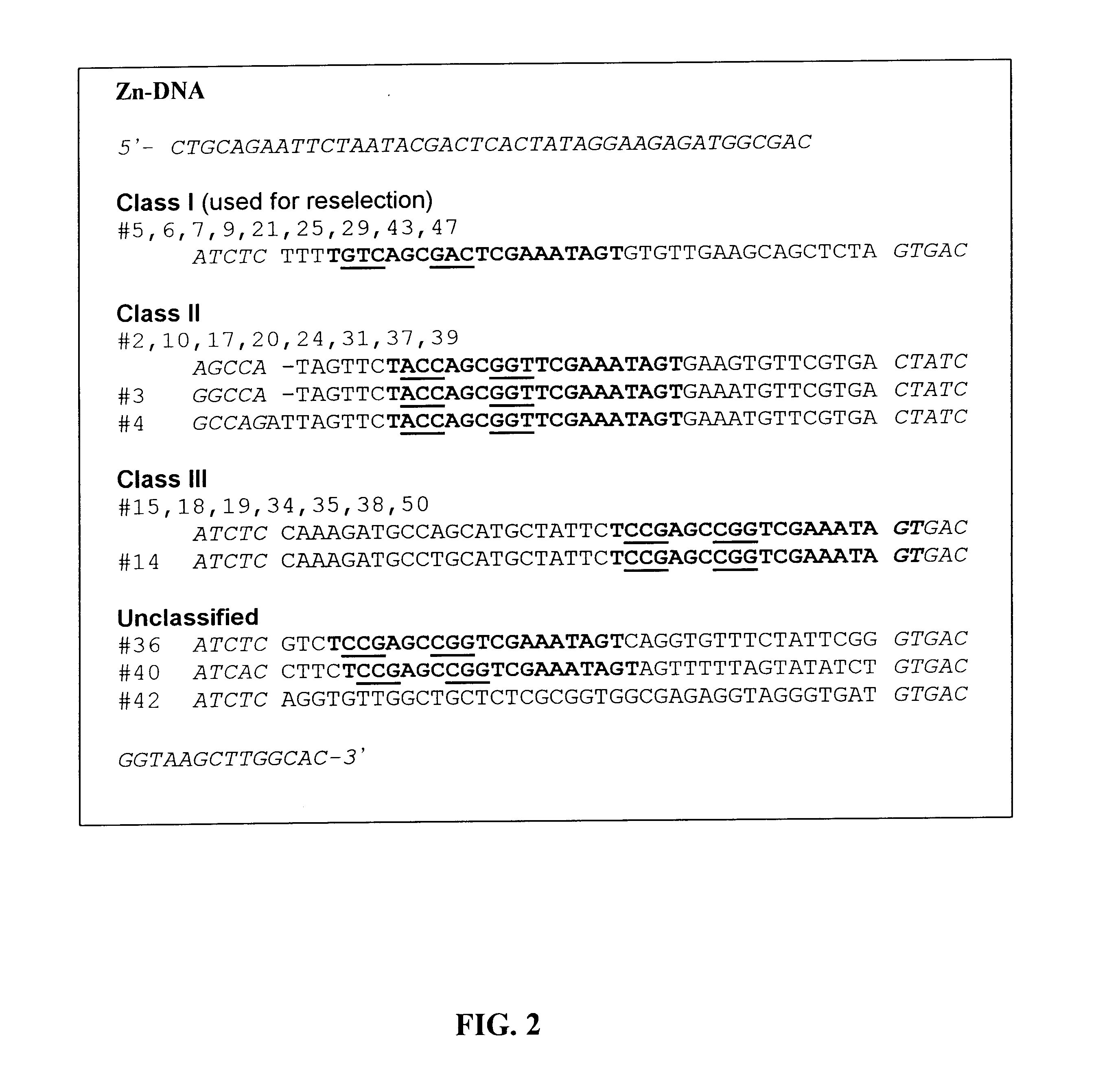Nucleic acid enzyme biosensors for ions
- Summary
- Abstract
- Description
- Claims
- Application Information
AI Technical Summary
Benefits of technology
Problems solved by technology
Method used
Image
Examples
example 1
In Vitro Selection of a ion-Dependent Deoxyribozyme
This example demonstrates a method of creating nucleic acid enzymes that are dependent on the presence of an ion for activity. More specifically, use of a partially random DNA library to obtain deoxyribozymes that cleave RNA in the presence of Zn.sup.2+ or Co.sup.2+ is shown.
Materials and Methods Used in This Example
Oligonucleotides
DNA oligonucleleotides were purchase from Integrated DNA Technologies Inc. Sequences of the random DNA template and the primers (P1, P2 and P3) used in PCR amplifications are listed below:
P1: 5'-GTGCCAAGCTTACCG-3' (SEQ ID NO:3)
P2: 5'-CTGCAGAATTCTAATACGACTCACTATAGGAAGAGATGGCGAC-3' (SEQ ID NO:4)
P3: 5'-GGGACGAATTCTAATACGACTCACTATrA-3' (SEQ ID NO:5)
Template for Random DNA Pool:
5'-GTGCCAAGCTTACCGTCAC-N40-GAGATCTCGCCATCTCTTCCT ATAGTGAGTCGTATTAG-3' (SEQ ID NO:6)
Primer P1b and P3b are the 5'-biotinylated version of primers P1 and P3. Primer P1a and P3a were prepared by 5'-labeling P1 and P3 with [.gamma.-.sup.32 ...
example 2
Deoxvribozvme as a Biosensor for Pb.sup.2+ Detection
This Example describes a fluorescence-based biosensor for the detection of Pb.sup.2+. The biosensor utilizes a deoxyribozyme developed in Example 1 (termed 17E) combined with fluorescence technology to allow quantitative and real time measurements of catalytic activity. Because catalytic activity is dependent on Pb.sup.2+, the biosensor provides real-time, quantitative, and sensitive measurements of Pb.sup.2+ concentrations.
Materials and Methods Used in This Example
Oligonucleotides
The oligonucleotides were purchased from Integrated DNA Technology Inc. The cleavable substrate (Rh-17DS) is a DNA / RNA chimera with the sequence 5'-ACTCACTATrAGGAAGAGATG-3' (SEQ ID NO:2), in which rA represents a ribonucleotide adenosine. This RNA base is replaced with a DNA base for the non-cleavable substrate (Rh-17DDS) (SEQ ID NO:11) used in the control experiment. Both substrates are covalently linked at the 5' end with 6-carboxytetramethylrhodamin th...
example 3
DNA Chip Comprising an Array of Nucleic Acid Enzymes
This prophetic example describes the production of and use of a DNA chip for sensing ions, in particular heavy metal ions.
The first step towards the application of deoxyribozymes in heavy metal sensing is to obtain various deoxyribozymes with different metal specificity and affinity. In vitro selection will be carried out to isolate a variety of deoxyribozymes. A detailed description of the selection protocol can be found in Example 1. Each family of deoxyribozyme will be specific for different divalent metal ions (e.g. Pb.sup.2+, Hg.sup.2+, Zn.sup.2+, Co.sup.2+, Cd.sup.2+, Ni.sup.2+, Mn.sup.2+, etc). Within each family, different sequences will have different affinities of the specified metal ion.
These deoxyribozymes and their substrates will then be arrayed onto a DNA chip with one dimension for metal ion specificity and the other for affinity of the corresponding metal (FIG. 11). The enzyme strands immobilized on the chip at 3'-...
PUM
| Property | Measurement | Unit |
|---|---|---|
| Lifetime stability | aaaaa | aaaaa |
| Concentration | aaaaa | aaaaa |
| Fluorescence | aaaaa | aaaaa |
Abstract
Description
Claims
Application Information
 Login to View More
Login to View More - R&D
- Intellectual Property
- Life Sciences
- Materials
- Tech Scout
- Unparalleled Data Quality
- Higher Quality Content
- 60% Fewer Hallucinations
Browse by: Latest US Patents, China's latest patents, Technical Efficacy Thesaurus, Application Domain, Technology Topic, Popular Technical Reports.
© 2025 PatSnap. All rights reserved.Legal|Privacy policy|Modern Slavery Act Transparency Statement|Sitemap|About US| Contact US: help@patsnap.com



